One of the questions I’m asked most frequently has something to do with the different kinds of baking flours on the market. What are they and why are they used for certain recipes?
Possibly the most important ‘specialty’ flour to understand is cake flour.
In fact, there are a couple recipes that I’ve made and some that I’ve published on the site that absolutely require cake flour. Using all-purpose flour instead will actually fundamentally damage the final result of the recipe. A good example of this is Angel Food Cake or even my Old Fashioned Sour Cream Doughnuts.
In order to answer these questions for you, I went crazy in the kitchen baking up multiple batches of cupcakes with the specific intent of creating visuals that illuminate the science of cake flour in an easy to understand way.
Don’t get me wrong, sometimes it pains me to intentionally make batches of anything that I know aren’t going to come out exactly right, but the photos are so valuable. They actually show you how different ingredients and techniques impact your favorite treats. Sometimes the differences are shocking!
I don’t know about you, but I’m such a visual person that the best way I can learn about the magic and science of baking is by seeing it in action.
So, I not only experimented with different brands (and styles) of cake flour, but also how cake flour substitutions work.
Cake Flour 101
Tools & ingredients used:
I made every effort to replicate each batch as perfectly as possible, using the same exact tools and ingredients whenever applicable. I used a kitchen scale to measure ingredients to ensure 100% accuracy. Each batch was baked separately but in the same oven at the same temperature for exactly 20 minutes.
I used Bleached Gold Medal All-Purpose Flour for the control batch and DIY cake flour. The two brands of cake flour I tested were Swans Down Cake Flour, which is bleached, and King Arthur Cake Flour, which is unbleached. Lastly, I baked the batches in my Wilton Cupcake Pan, using a large spring-loaded scoop to fill each cavity evenly with batter.
All the cupcakes were baked on the same day to be photographed together. Before I reveal some of those photos, let’s cover the basics you need to know.
What is cake flour?
Cake flour is very finely milled from soft wheat from the heart of the wheat endosperm. This helps to give cake flour its very fine silky soft texture. That fineness is actually why cake flour should be sifted before use as it’s more likely to clump together.
What is the difference between cake flour and all-purpose flour?
The primary differences are that each flour is made from a different variety of wheat, milled to a different texture, and contain different amounts of protein vs. starch.
Cake flour has the lowest protein content of most flour products available:
- Bread flour: 12-15% protein content
- All-purpose flour: 9-12% protein content
- Pastry flour: 9% protein content
- Cake flour: 6-8% protein content
Protein content differs by brands and even styles of flour under the same brand. To figure out the protein content in any flour, divide the number of protein grams per serving by the number of total grams per serving.
This lower level of protein means cake flour also has more starch. Overall, the use of cake flour in a recipe will discourage gluten formation compared to a higher protein flour product. Lower levels of gluten equal more softness and tenderness in a baked good. Think of something that has a really high level of protein, like steak. It’s tough and chewy. When we want the opposite of that texture, we want lower levels of protein to a soft and delicate crumb.
By contrast, this is why bread flour has more protein than all-purpose flour and certainly more than cake flour. Breads require that extra protein to form strong gluten webs that shape the backbone of a loaf and create that slightly chewy, bready texture.
Is cake flour bleached or unbleached? (This is important!)
Cake flour is typically bleached, which further weakens the proteins and prohibits gluten formation. Bleached flours in general soak up more water and produce thicker batters.
In the photos below, I actually tested Swans Down Bleached Cake Flour vs. King Arthur Unbleached Cake Flour to show you just how important this one detail can be! But before we get there, let me clear up some common misconceptions about bleached flour.
The bleached flour you buy at the supermarket does NOT contain chlorine in the final product. When flour products are chlorinated, manufacturers treat the flour with an extremely low level exposure to chlorine gas to provoke a chemical reaction. That chemical reaction not only changes the flour’s characteristics (more on that below) but it changes the chlorine itself. The chlorine turns into several other compounds: chlorite (which occurs naturally in unbleached flour), hypochlorous acid (found in our own immune cells), and chloride (an electrolyte found in a product like Smart Water). However, this is just one method of bleaching flour. You can learn more about flour bleaching here.
Bleached flour actually allows more moisture to be absorbed in a batter or dough to make dough less sticky and easier to handle. This can also help prevent excess spread in baked goods (think cookies). It improves the structure and height of cakes. It can make taller, sturdier breads. It also makes the flour more shelf stable and will not kill yeast.
There’s tons of sources on this in scientific publications, here’s one on the safety of consumption.
Are cake flour and pastry flour the same?
Where cake flour has a protein content of 6-8%, Pastry Flour is around 9% and has less starch than cake flour. Pastry flour is also typically unbleached unlike cake flour, so it will absorb less liquid in a recipe compared to cake flour. If you’re in a bind and only have pastry flour for a recipe that calls for cake flour, it’s better to use the pastry flour than all-purpose flour if you’re in a pinch.
Testing Cake Flour Substitutions
Let’s get into the experiments!
The fact that cake flour is made from a different variety of wheat, milled differently, and is often bleached, makes it behave very differently than all-purpose flour in terms of how it affects the chemistry of a recipe. This also means it’s impossible to recreate cake flour exactly at home using “DIY” substitutions. That’s why I was so eager to compare side-by-side cake flour vs. all-purpose flour vs. DIY cake flour.
I had a suspicion of how this experiment would turn out, but I wanted to be 100% sure. I know many of us don’t always have cake flour in our pantries so it’s kind of an annoying ingredient when you see it called for in a recipe!
Yet because of all of the baking experiments I’ve done, I know one small, seemingly insignificant change can have drastic results in baking.
Control Recipe: All-Purpose Flour
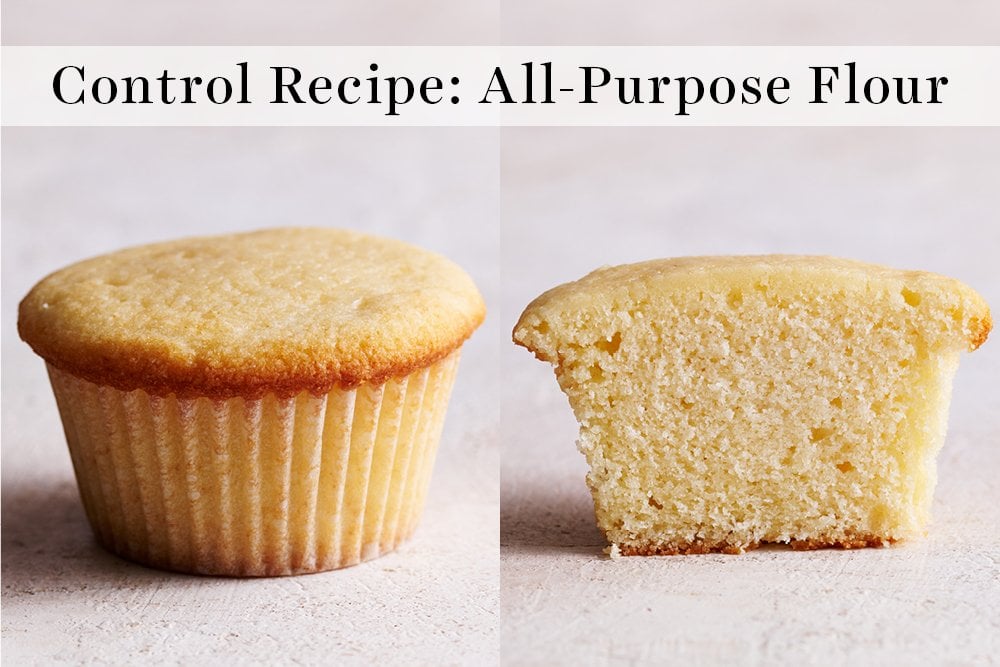
The cupcakes I baked were based on my standard cupcake recipe you can see at the bottom of this article. I re-made the same recipe each time, simply changing out the flour for each batch you see below.
These control cupcakes were soft yet sturdy with a slightly open crumb. They weren’t super tall and had some cracking on top that I think visually reflects the slight chewiness they had. Basic yet delicious and full of vanilla flavor.
DIY Cake Flour
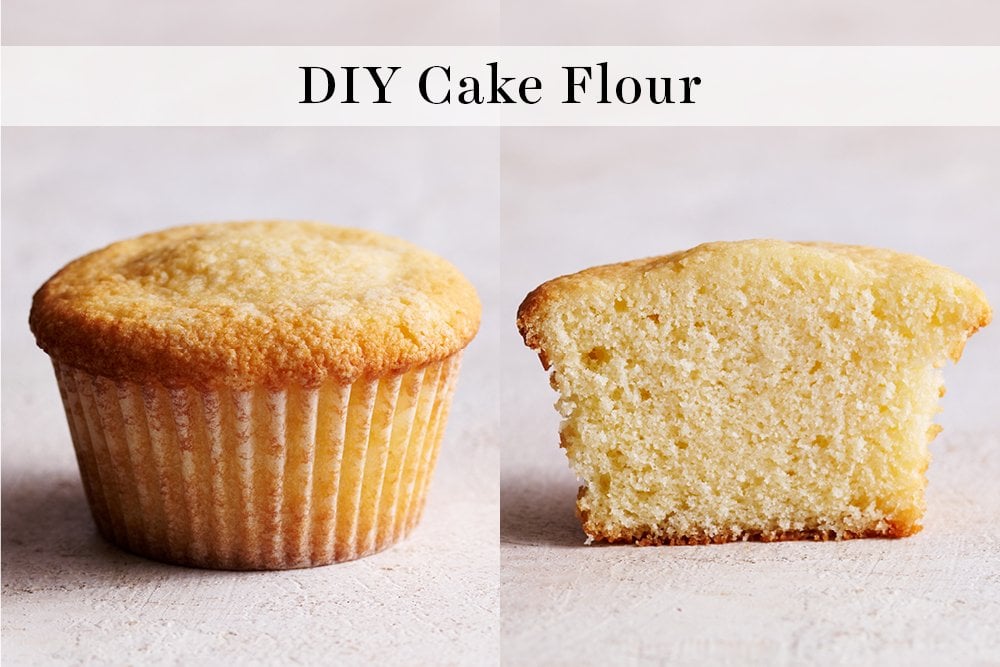
Using the DIY cake flour technique just below, these cupcakes turned out visually more like the control / all-purpose flour cupcakes than the cake flour cupcakes. Their texture was another story. These were more crumbly and had an almost gritty texture which I’m attributing to the cornstarch. They almost felt like they dissolved in your mouth, which honestly, I didn’t care for. I won’t be using DIY cake flour in my baking… even if it’s a total pain to run to the store to grab cake flour!


How to Make DIY Cake Flour
Although I would NOT recommend using DIY cake flour based on our experiment results, here’s how I did so:
1 cup minus 2 tablespoons all-purpose flour + 2 tablespoons cornstarch
Then I sifted this flour + cornstarch mixture 5 times with a fine mesh strainer.
Comparing Brands of Cake Flour: Which is the Best?

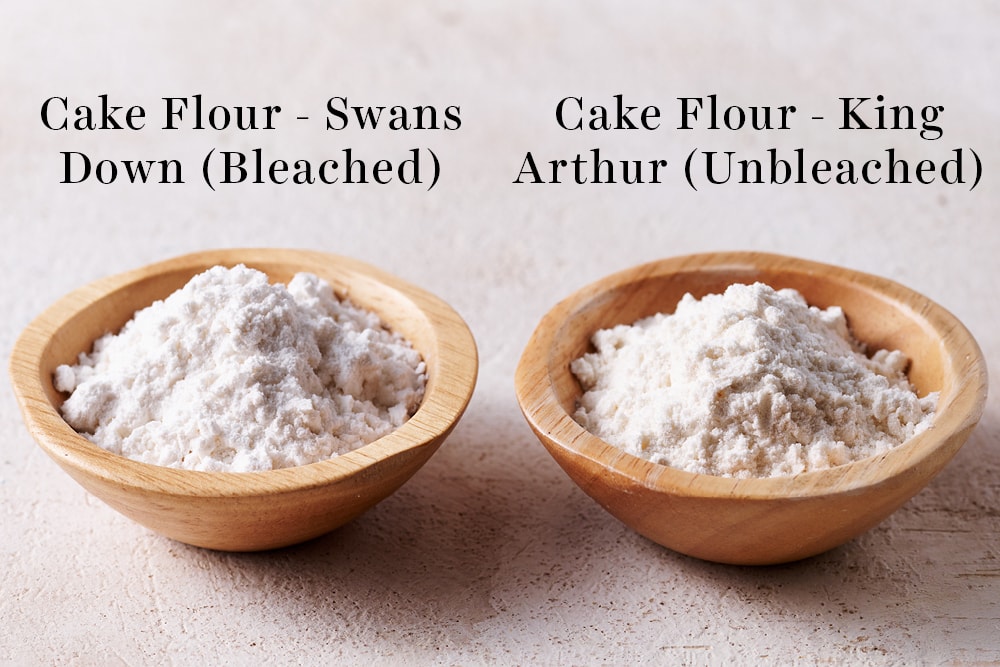
Cake Flour – Swans Down (Bleached)
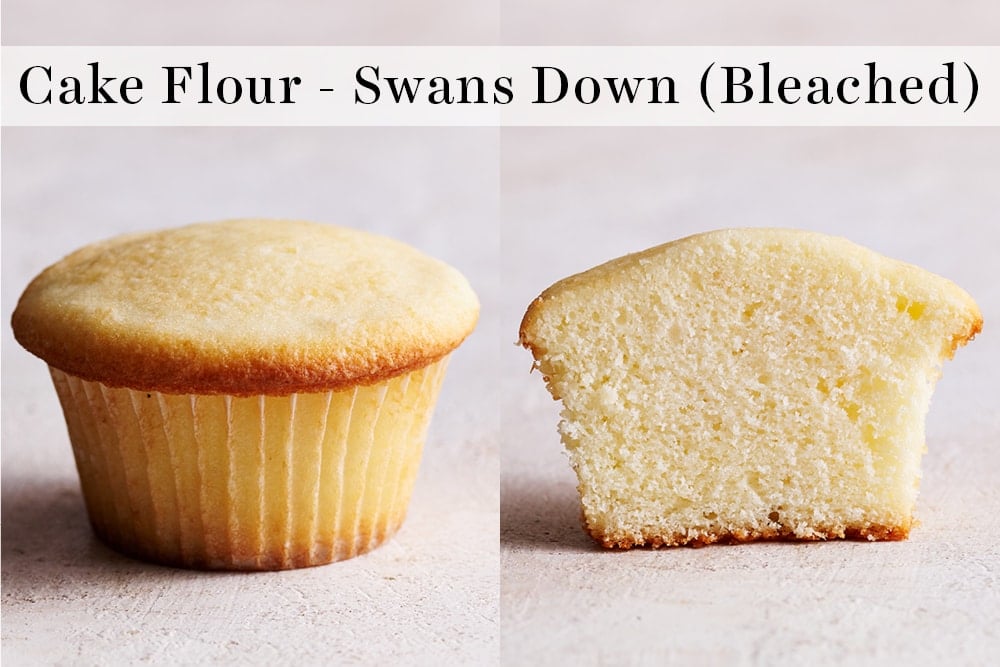
I used the same amount of Swans Down Cake Flour in place of the all-purpose flour in this batch. These cupcakes baked up pale and tall with a spongier and softer texture. The softness actually reminded me slightly of a more commercially produced cupcake but not necessarily in a negative way. They were much more soft and delicate that I don’t actually think they’d hold up well to a heavy or generous frosting or filling. They also had slightly less vanilla flavor than the all-purpose flour cupcakes.
For me, I tend to prefer cupcakes made with all-purpose flour instead of cake flour. However, for some recipes like Angel Food Cake or certain layer cakes, cake flour really helps to create that fine and delicate crumb characteristic of that style of recipe. In those cases, it really shouldn’t be substituted!
Cake Flour – King Arthur (Unbleached)

I was SO excited to see the comparison between the Swans Down and King Arthur Flour cupcakes to see what impact bleaching had on the final result, among other variances between the two brands.


Although I love King Arthur as a brand, their cupcakes were noticeably less flavorful than the all-purpose cupcakes. Compared to the Swans Down cupcakes, the King Arthur cupcakes had an almost corn bread texture. I’ll be sticking with Swans Down when I need to use cake flour.
Cake Flour vs. Substitutions Final Comparison
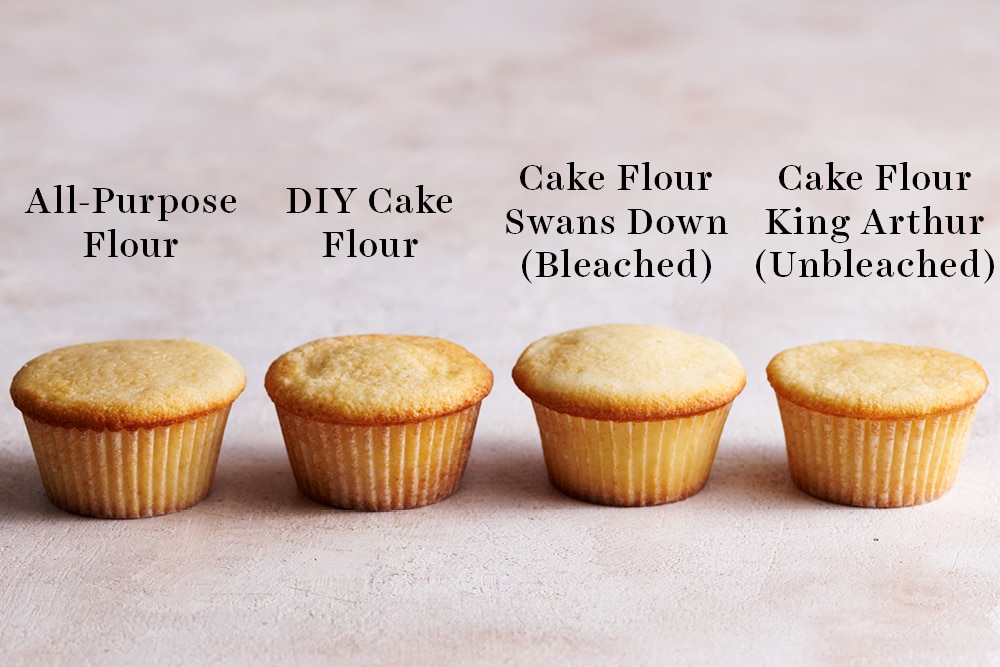

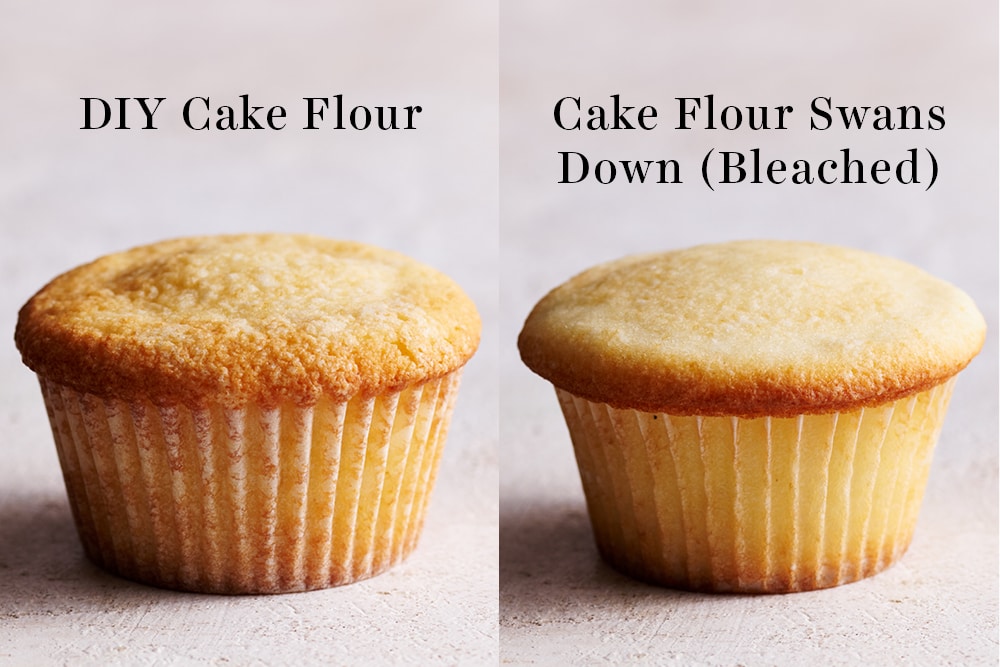


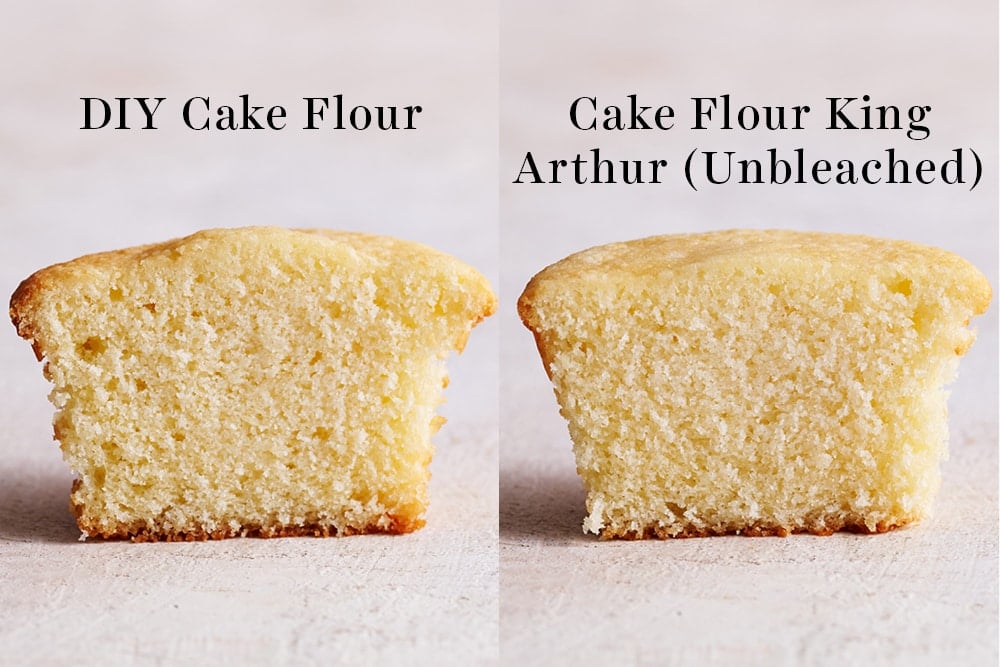
I think visually, these comparisons do a good job of proving the belief I’ve always held that nothing is quite as good as the real thing.
So the final question is…
Can Cake Flour be Substituted?
It shouldn’t be. Recipes that use cake flour are typically more delicate and finicky and require the exact ingredients called for.
In fact, 90% of substitutions you make in baking will alter the taste and texture of the final result. Sometimes substitutions are necessary, and I understand that. However, the Handle the Heat method of baking recommends that you always follow the recipe exactly as it’s written… at least the very first time you make it so you understand how it’s supposed to turn out. Then you can experiment with substitutions and alternatives.
Does cake flour go bad?
Luckily, since cake flour is refined and bleached, it will keep in your pantry for a long time. If stored in a cool and consistently dry and airtight place, it should last at least 6 months if not up to a year. So why not have some on hand for those few recipes that use it so you can really take your baking to that next level?

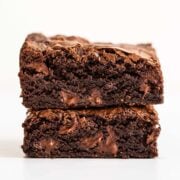

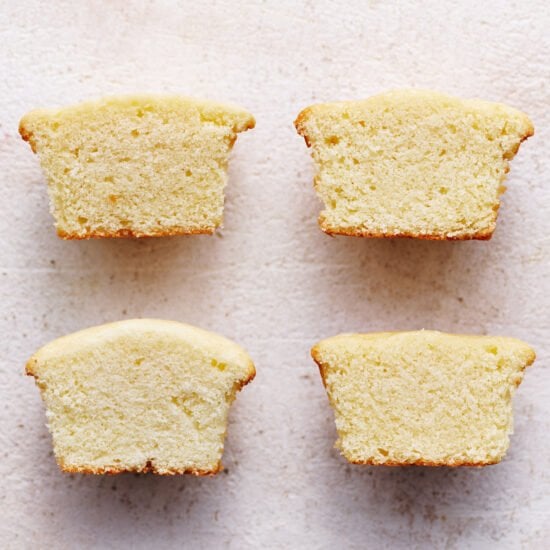
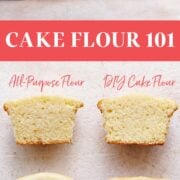
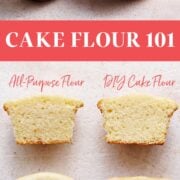
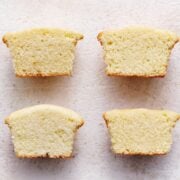

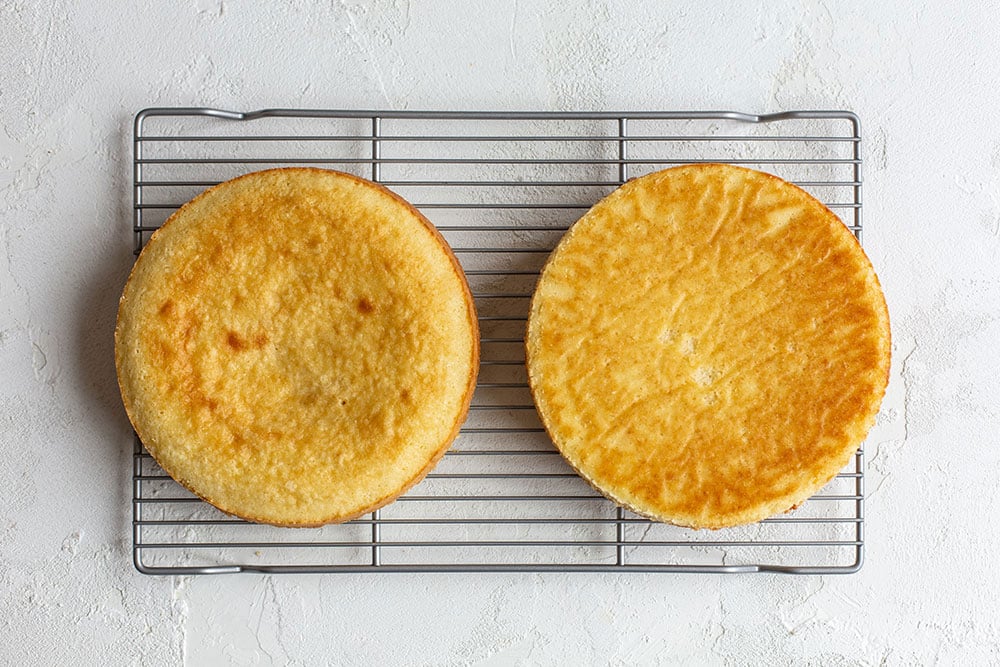
















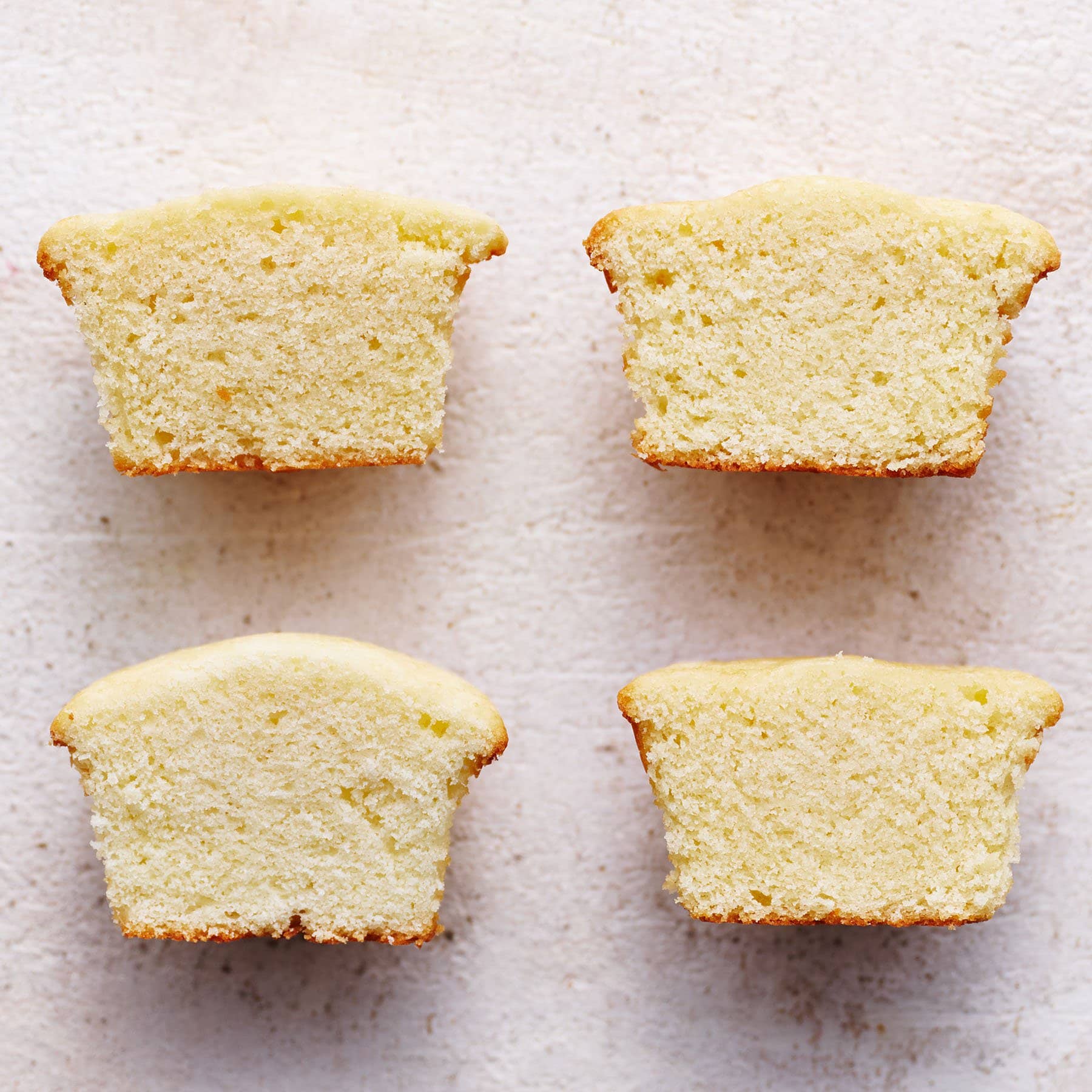


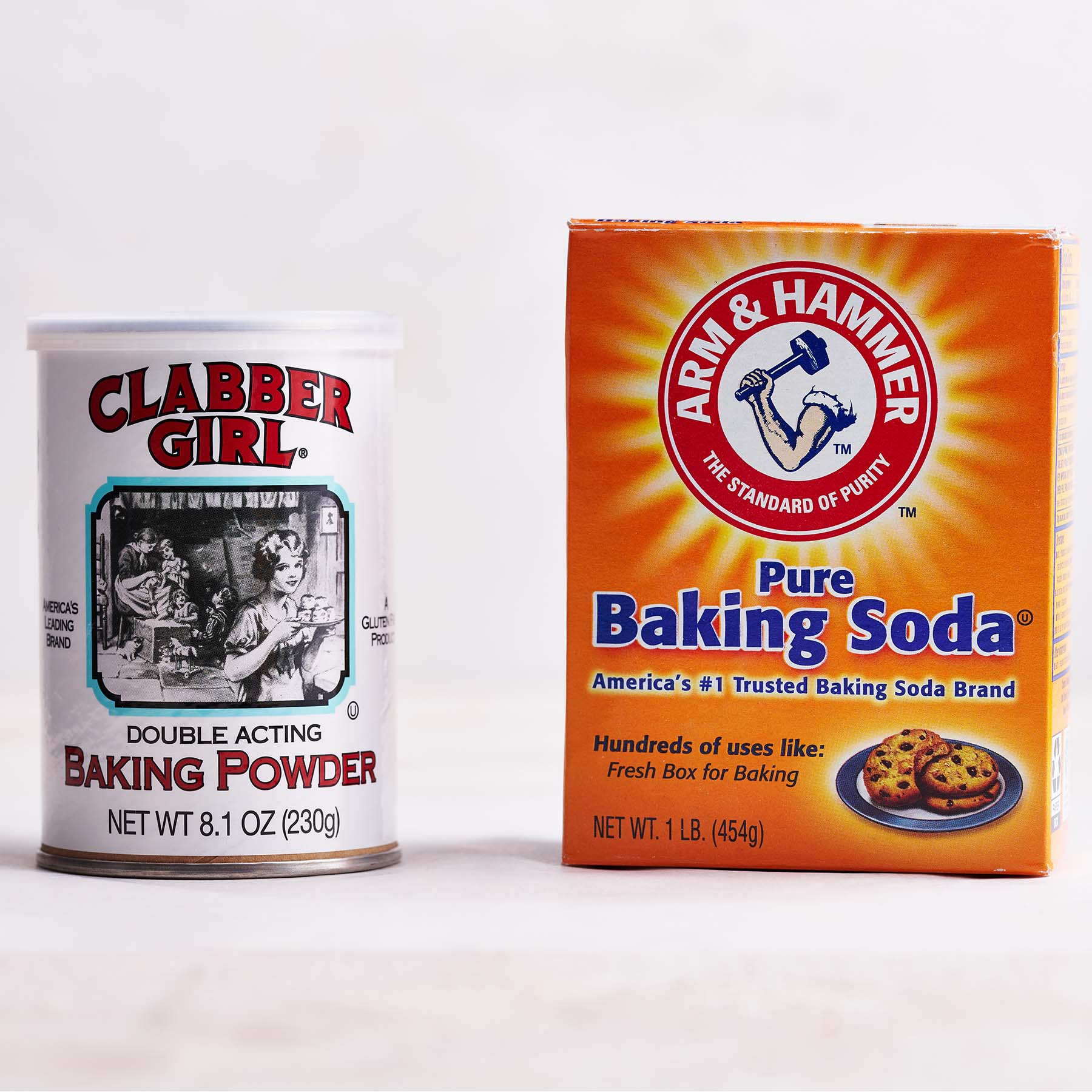





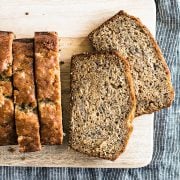
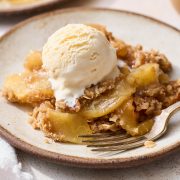
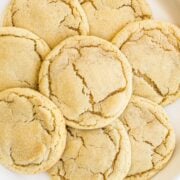
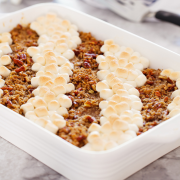

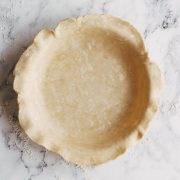
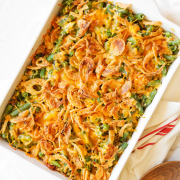
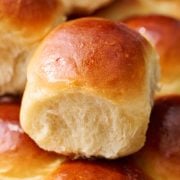
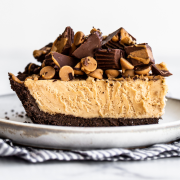

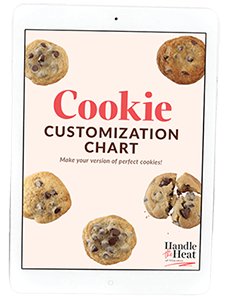
This is such a helpful article, thank you. I’ve been baking for decades but never bothered to look into this subject and it is really valuable information I will definitely remember. Especially with the helpful visuals!
Thank you for helping me with flour. It’s still complicated but I get it. You need to write a boook with all your helpful problems that we can have and to understand them.
Hi Tessa, I would like to make a cake using cake flour but the recipe calls for all purpose flour. Sally from Sally’s Baking addiction lists that 1 cup all purpose flour is 125 g while 1 cup cake flour is 118 g. Should I use the 125 g of cake flour for my cake or use the 118 g? Thank you in advance
Hi Vanessa! We always recommend making the recipe as written first, before experimenting with substituting or altering any ingredients, so you have a baseline knowledge of how the recipe should turn out. If you then wish to try substituting the AP four for cake flour, try this ratio: 1 cup AP flour = 1 cup + 2 tablespoons cake flour. Just be aware that this substitution of flour, containing a different protein level, will certainly result in a different outcome, and may require some tinkering and experimentation to perfect. Alternatively, here are a couple recipes Tessa has created, containing cake flour, that you may be interested in:
– Funfetti Cake
– Angel Food Cake
I hope that helps, Vanessa! Happy baking 🙂
Hi! Thank you for your time and effort behind each experiment we all learn so much from you…
Searching for cake flour brands just realized that brands like pillsbury or Betty croker are baking mix, so is a total different product, right??
Hi Eva! Yes, boxed cake mixes like that are totally different products! Cake flour is a specialty flour, and the only brands I’m aware of for sale in grocery stores in the USA are Swans Down and King Arthur – which are the two brands Tessa used for her experimenting here! I would recommending trying out either of those brands if you are looking to make a recipe using a cake flour. I hope that makes sense! Feel free to reach back out to us if you have any further questions – we are always happy to help! 🙂
Hi Tessa- I HAVE NOT MADE THE RECIPE! Rather, I encountered your site, in my long, aggravating search for A.P. flour vs. cake flour ( I purchased several boxes of Swans Down from Amazon; I have not used the Swans Down yet.) substitutions in recipes. My mom, born in 1930 (deceased now) was a really-good cook, born-and-raised in the deep south (Mississippi, Louisiana, and Georgia, where I reside now). I learned a lot about cooking from her (I am her son). I am a perfectionist. Anyway, mom just always used all-purpose flour, for her baking sweets, so, that is what I used, for decades. I made 2 French-Apple cakes recently (Epicurious recipe); in spite of my care in following directions, the cakes were just too dense (I used A.P. flour). I know Swans Down must be sifted before use. However, ALL of the websites I view on the subjects of 1) How many grams are in one “cup” of BLEACHED Swans Down cake flour, vs. one “cup” of A.P. flour, I can not get a straight answer from (Almost all the cake recipes I find, call for A.P. flour, in “cups”, i.e., 1 cup, or 11/2 cups, 2 cups, 21/2 cups, except for sites like Great British Chefs, which cite metric.). Obviously, I want to measure my flour ingredient by weight. I mean, really, my issue is simple, which is: One cup of measured volume UNSIFTED A.P. flour, poured into the measure cup, NOT packed (as may be required in a particular recipe hypothetically) is converted to how many grams of Swans Down bleached cake flour SIFTED??? A couple sites talk about unbleached cake flour (King Arthur) conversion-confusingly-(if they are to be believed) to A.P. flour. https://www.joyofbaking.com states 1.0 cup un-sifted “cake flour” weighs 120 grams, and, 1.0 cup of sifted “cake flour” [bleached or un-bleached????????] weighs 100 grams; that is good, BUT WHAT IS THE EQUIVELENT VOLUME OF A.P. FLOUR, for a “backward” conversion?? I think you understand my issue: 1 cup of VOLUME-measured, POURED into a measure cup un-sifted A.P. flour (as is predominately called for in cake recipes), equates to how many GRAMS of bleached, sifted Swans Down cake flour???? And if you know this, then the conversions of like 1.25 cups, 1.50 cups, 2.25 cups, 2.50 cups of A.P. flour (as above cited) equals how many grams of the Swans Down (above cited)?? If I am going to expend the patience, time, and money to bake, I must do it correctly! I do not like inferior results, i.e., dense, heavy, chewy cake. Thanks so much, for your time!
Hi Mike! I actually wouldn’t recommend swapping one out for the other as it’ll change the chemistry of the recipe. It would requiring some experimenting on your part if you wish to alter a recipe written with AP flour, to cake flour. If you do wish to experiment, I hope this helps: in our experience (and the way Tessa writes her recipes), 1 cup AP flour, unsifted, = 127 grams. 1 cup bleached Cake flour, sifted, = 113 grams. I also recommend checking out this book to help your quest. I hope this helps! Good luck with your experiments!
Thanks! I really appreciated the visual comparisons
So happy this helped, Lana!!
Thank you for this. I have used King Arthur’s cake flour for two different recipes and did not like the results both times. Now I have a better understanding as to why.
So happy you found Tessa’s article helpful, Arleny!! Happy baking 🙂
I am so thankful for bakers like you who go all in for the testing for bakers like me to just google knowledge.. thank you so much for the flour testing!!! Lori K
Hi Lori! I’m so glad you found Tessa’s deep dive here so helpful! I just wanted to take a moment and mention our new Baking School – coming soon! It’s entirely virtual, so you can study with Tessa and learn her incredible baking tips and tricks, as well as the science behind baking, all from the comfort of your own home! If you’re at all interested, you can join the Waitlist here, and receive more information (as well as pricing, details, etc) in the next couple of weeks, before our doors officially (virtually) open! I think you’d love being a part of our community of passionate home bakers 🙂 Happy baking!
Hi Lori! Boy I had a hard time trying to figure out how to reply to you! Check out CUPCAKE JEMMA on UTUBE for some GREAT tutorials for NYC style cookies! Located in the UK, so conversations were necessary, and I invested in a digital scale for accuracy, but BOY soooo worth it! BEST cookies in my 50 years of baking!
Hi! Loved this article, this approach, these results, just about everything about it! I just wanted to leave you one piece of feedback. I don’t know how under your control the ad experience is, but I had to send this to myself from my phone to view it on desktop because the page was utterly unusable on my phone. It seemed like every paragraph was followed by an ad just as tall as it, and a few of them didn’t load correctly, leaving big, confusing gaps throughout the page. Perfectly readable, usable, and navigable on desktop, but if I had been without that option, I likely would just back out and give up.
Again, thanks so much for this piece, this is just website feedback!
Hi Josh! I’m so sorry to hear that you’re experiencing so many ads! This is something we’re currently working to improve! There should be a small “x” to close some of the ads. If this happens again, please take a screenshot of what you’re seeing and email me at [email protected] so I can share it with our tech team. In the meantime, if you click on the print icon for any of our recipes, or the recipes used in any of the Science of Baking articles, it will “reformat” the recipe without ads. I hope that helps! Thank you for the feedback, and we are so happy you persevered through all the ads, to still find Tessa’s experiments and baking science helpful and interesting 🙂
Can I substitute extra fine cake flour for same amount/weight of self raising flour in recipes?
Thanks.
Irene
Hi Irene! They are different flours, used for different purposes, so you can’t always interchange the two easily. As Tessa explains in the article above, cake flour contains a very low protein content, which makes it perfect for very delicate cakes; whereas self-rising flour is a little higher in protein content, and includes ingredients to help your baked goods rise. You can generally substitute all-purpose (plain) flour for self-rising flour with the addition of some leavener and a little salt, but it really depends on the recipe. Our advice is always to make the recipe as written the first time, and experiment from there if you like! Please feel free to reach out to us at [email protected] for any further help 🙂
Great info!!!
What’s the difference between cake flour and AP flour in cakes? Can I replace AP for cake flour? Or viceversa? How would my cake change in texture and flavor? Do you know? Thanks!
Maria,
She went over these questions in the article really well. You’ll find your answers there, good luck!
Literally the point of the entire post…
I read this just for the information. WOW! BEST article and explanation of flours. I am into baking the NY Style cookies and talk about precision! Thanks so much!!!
So happy to hear this helped! Thanks for the comment 🙂
Hi Vicki, NYC Cookies are my passion too!! I use Swans Cake flour for my Black and White Cookies, but have not for any other of the Italian Cookies. I guess I will be getting rid of all the King Arthur Cake Flour I bought, ugh. What other NYC cookies do you think would do well with cake flour? Curious!!! Lori
Excellent information as always. Thank you.
I do have another question: How do you determine whether you will use 1-1/2 cups, 1-2/3 cups, 1-3/4 cups, 2 cups, 2-1/4 cups, etc.?
It seems like even if the flour varies, a recipe still yields the same 12 cupcakes or muffins. Thank you.
Hi Janine! I’m not quite sure I understand what you’re asking. Can you please elaborate?
Emily, thanks for asking. Why do so many baking recipes for the same item call for such differing amounts of flour to yield the same product? In other words, for example, what makes you decide to use 2 cups of flour instead of 2-1/4 cups? Thanks.
Gotcha! The amount of flour can vary on what you’re baking, but also due to the other ingredients in the recipe. So for example, we have quite a few chocolate chip cookie recipes on our site, but you’ll notice each is different. For some recipes, we were looking for a thicker, more chewy cookie, others a crispier, thinner cookie. Tessa will test a recipe until it has that perfect texture, and that may include adding additional ingredients, like corn starch or cream cheese, but also increasing or decreasing the amount of flour. It truly depends on each recipe! I hope that answered your question!
Thank you, Emily, for taking the time to answer my question. Have a stellar 2022!
Loved this article. Very informative.
I haven’t made the recipe but was intrigued with the comparison. With that said, I’m making a strawberry and cream cupcake for 8/28/21 outside wedding. I will actually cut be cutting the top off and placing “whipped cream” with fresh strawberries on base and retopping it and dust with powdered sugar.
What would you use for the “whipped cream” so it stays well and not melts?
I’ve researched stabilized whipped cream and thickened Cool Whip recipes.
Thank you,
Carol Roberts
Hi Carol! Tessa likes using this Stabilized Whipped Cream recipe; however, you definitely want to make sure your cupcakes are kept in cold storage for as long as possible and also kept out of the sun! Hope that helps, your cupcakes sound absolutely delicious!
Is there any ways to lower the protein in unbleached cake flour? I tried adding in corn starch but the outcome of my cake is still heavy and dense 🙁
Honestly, I always recommend using bleached cake flour. While adding corn starch might dilute the protein, it also increases the starch in a totally different way, which can make a cake that bakes up heavy and dense.
I moved to New Zealand a few years ago and just today noticed the protein difference between US to NZ “all-purpose” flours, as well as every known brand of flour to man. Why can’t there be a fixed standard? Or why can’t flour be identified by the number of protein percentage? In both recipes and on the store shelves? (rhetorical questions for complaining purposes only)
Thank you for your flour substitution test! I came across it yesterday, which lead to today’s discovery. Hopefully the information leads to better baking.
I have a cookbook with cake recipes calling for “cake and pastry flour.” I’m stumped. I think it’s a Canadian thing, but now that Bob’s Red Mill has nixed their cake flour and King Arthur’s cake flour is high in protein and the two supermarket brands are more like 7%, I’m pretty much left with pastry flour. King Arthur sells in 3 lb bags and it’s costly, and Bob’s Red Mill is 8.5-9%. What should I use that I can actually buy? I know the southern brands of AP flour are at the sweet spot, but they’re expensive too. Please help. Should I just use the Bob’s pastry for cakes calling for “cake and pastry flour.”
Here in the UK we have plain flour, which I assume equates to US all purpose flour, I’ve also seen something called extra fine sponge flour, which I’ve never used but is described as being extra fine from British soft wheat varieties. Would this equate to your cake flour? Both types seem to be the same protein content.
It sounds like it would, but I’m really not sure as I have no personal experience with it.
Hallo Mary, I live in the UK too and, as far as I know, all-purpose flour is plain flour plus baking powder (or is it soda bicarbonate?). Fine sponge flour is for sponges only.
Hi Beatrice! All-purpose flour in the U.S. doesn’t contain baking powder, it equates to UK’s plain flour. I think what you’re thinking of is called self-rising flour, which includes a bit of baking powder and salt in its mixture (Tessa doesn’t use self-rising flour as she prefers the customization and flexibility to make her own mixup of ingredients [flour and leavener/salt] and not have to rely on whatever the manufacturer made in their container of self-rising flour.). We’re unfortunately not familiar with other flours in the UK, I wish we could help find an equivalent!
Oh, right. Thanks. Sorry for the confusion!
I have a question on the cake flour where eating over-processed foods is a concern. By default, bleached cake flour is one of the most processed versions of flour that we can use. How would someone who cannot properly digest this type of flour compensate with the use of other flours?
On a similar note – Would you have any suggestions in regards to gluten free options (coconut flour, almond flour, etc…)?
Thanks!!
Have you found an organic cake flour? You should consider doing a test batch comparing organic whole wheat pastry flour to cake flour.
Keep doing your experiments we both love the information!!! We (we both love to bake) find your information both insightful and accurate. One of our favorite recipe is making Banana Bread (we live on the Big Island of Hawaii) and since we use whole apple-bananas the bread tends to come out with uneven texture. Now we are going to try both the DIY and the real cake flour to see if it makes it better. BTW we found freezing the banana pulp for a few days improves the flavor and evens out the moisture content problem. It also helps to freeze carrots for carrot cake. Try that for an experiment, you and your readers will be shocked at the results !
I love this experiment! Helped me a lot. I am opening my own bakery and I used to bake using cake mixes, but now I am going all made-from-scratch, so I have been doing a lot of experimenting- it is a learning curve, but well worth it!
Could you do a test comparing cake flour and sponge flour please? Thanks.
I would like to see comparisons using bleached an unbleached flours.
Thanks!!!!
I would like to see comparisons using bleached an unbleached flours. When baking cookies, I use unbleached flour. Also, thank you for this article using cake flour. The next time I bake cupcakes, I will use it.
Tessa,
I have always dreamed of going to culinary school, so the baking nerd inside me absolutely “geeks” out every time you post a side by side comparison. I truly had no idea there was a difference between bleached and unbleached flour and have always bought unbleached when available. Also crazy interesting to know DIY cake flour is not the same, I felt the same way when I learned this about DIY buttermilk, as I had almost exclusively been making my own instead of throwing away 3/4 of a bottle every time I want cornbread or red velvet cupcakes.
Thank you for taking the time to do these experiments and share with us!
I would like to see the comparisons of bleached and unbleached flour.
Maybe I’m missing something, but I’m confused.
1. The heading at the bottom of the page says “how to make cake flour 101” and is followed by a recipe for cupcakes using all-purpose flour. Shouldn’t the heading be something like “recipe for test cupcakes”? the actual “how to make cake DIY cake flour” was in the text above.
2. and am I correct in understanding that to make this recipe with cake flour, you replace only 1-1/2 c all-purpose flour with 1-1/2 c cake flour? you leave in the baking powder because we’re not talking about self-rising flour, that’s a different topic, right?
3. you showed the 3 different results but don’t really “announce” a definitive winner, as it depends what kind of texture is desired, correct? if you are using lots of buttercream frosting, as you said, you would *not* want to use cake flour because the cupcakes would be too soft. so you showed the different results so the reader can choose which texture/traits they prefer, correct?
4. did you consider using 1/2 cake flour and 1/2 all-purpose flour? so they would be a little softer but still strong enough for filling or frosting?
thanks! I love this whole concept of side-by-side, visual comparisons, it’s super useful and I don’t think I’ve seen this anywhere else.
I think you’ve answered most of your own questions! The heading at the recipe is automatically generated so it’s something my web designer will have to hand code to make it clearer. Yes, correct to point #2. Correct to point #3. For point #4, yes half and half would be a good balance depending on what you’re looking for.
Tessa, I love these science of baking posts. I know they require a lot of work on your part so Thank You! I am curious, you say that the cake flour cupcakes would not hold up to a lot of frosting, so how do you know (other than trial and error) when you want a higher protein content to your flour? Is there a way to tell on the packaging to know the protein content of the flour? (There can’t be much difference between a 8% cake flour and a 9% all purpose flour.)
Yep, you can calculate the protein content by looking at the nutritional label… or avoid the math and just Google it 😉 It does take some trial and error to get a sense for what work work best and when.
Well. That was kind of sad and interesting. Our self rising flour I think it’s more like the cake flour in the US.
I’ll be checking the protein content in all our flours
hello,
i live in australia and i dont think the measuring cup and table/teaspoon is the same in America.
do you think you will be able to show any grams in table and teaspoon next time you publsih a recipe?
Hi! Did you see grams are included for the dry cup measurements already? Most scales built for home use aren’t accurate enough to decipher small amounts of weight such as tablespoons and teaspoons so I don’t use weight for those measurements.
Thanks! I love these comparisons, and learn a lot from reading them. I’m curious if the results would be the same if you used a recipe that calls for cake flour as opposed to AP flour as the basis for the comparison.
I’m so glad that you’re bringing back the experimental posts! This entire page was super interesting to read and I love that you took side by side pictures! Thank u! I never realized how much of a difference there is between store-bought cake flour and DIY cake flour.
I’m so glad you like these posts, Dalya!
I’m working with King Arthur cake flour these days, and I like it very much. Have you played with it at all?
No I haven’t because it’s unbleached, so it literally won’t work for some recipes like angel food cake.
This is bad news as we don’t have cake flour in Germany and I HAVE to substitute. And is that correct that cake flour has less gluten???
Oh no, Jenny! Can you order it online? Cake flour has less protein, so it will form less gluten when mixed in a batter. The differences between cake and AP flour are quite astounding!
What about mixing AP with Cake Flour….? Will we get the best of both worlds?
In some recipes, yes! It just depends on your desired result and preferences 🙂
Have you done any experiments with bleached flour vs unbleached flour? I always use pastry flour for anything that doesn’t have yeast. Fortunately there is a co-op near me where I can buy 25 lb. bags.
I have! When it comes to AP flour, bleached vs. unbleached doesn’t yield a massive difference. Unbleached flour will take on the properties of bleached flour as it ages as well. Would you like to see a side-by-side comparison like I’ve done here? I can add that to my list if there’s interest 🙂